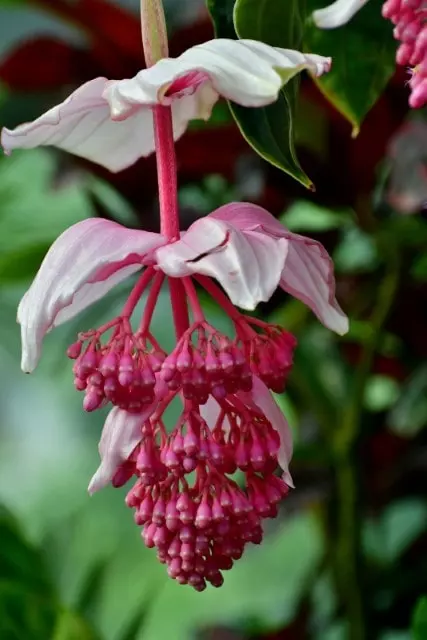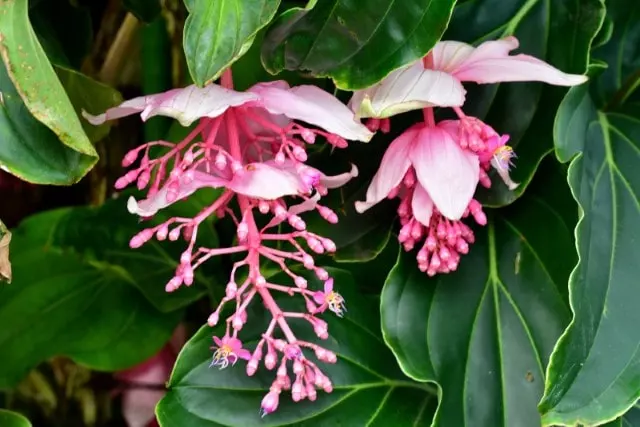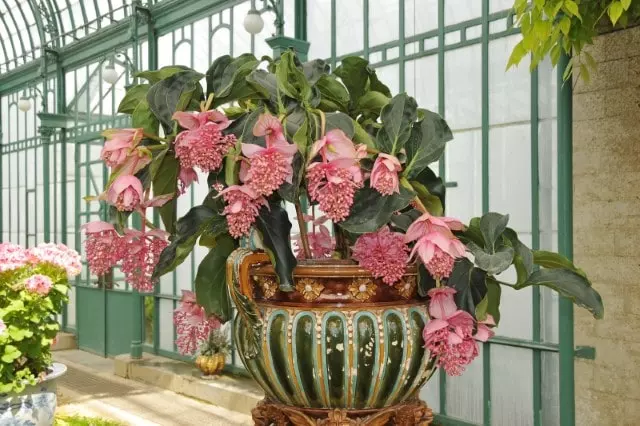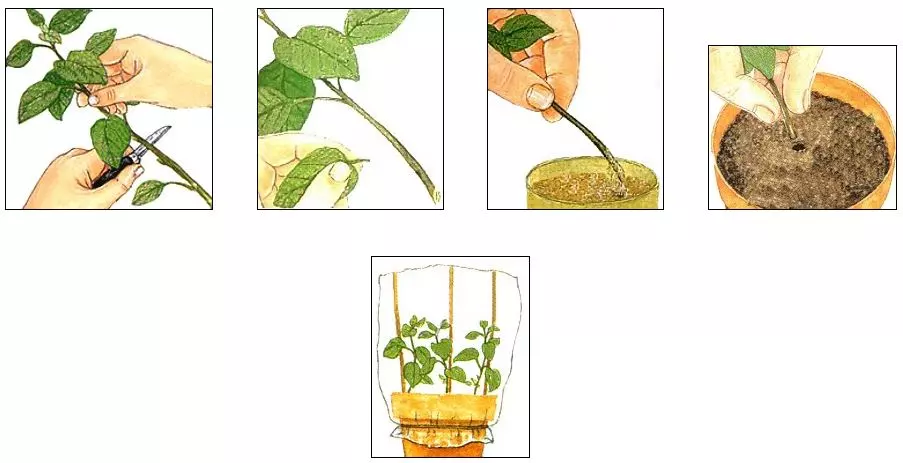The Medinilla magnifica is a little-known plant, but of a spectacular image, which stands out for its large leaves of bright green and its impressive inflorescence, of a showy pink. It tends to be grown as a houseplant because of its needs, which are somewhat demanding but are within the reach of anyone who takes the trouble to know them and spend a little time with them.
Medinilla magnifica is also known by the following names:
- Rose Grape
- Philippine Orchid
- Pink Lantern plant
- Chandelier tree
If you want to learn how to care for the Medinilla magnifica, keep reading this article.
Table of Contents
Characteristics of the Medinilla magnifica
These are the main characteristics of Medinilla magnifica:
- Medinilla magnifica belongs to the genus Medinilla, of the Melastomataceae family, which is made up of tropical plants native to Sumatra, the Philippines, Java, and Madagascar.
- Magnifica is a shrubby species, which in its natural environment can grow to over 6.5 ft (2 meters) in height, although in pot cultivation it maintains a much more controlled size, 3.3 ft (1 meter) at most.
- Its leaves arise from woody stems, are oval and leathery, with white or light green veins very marked, and can measure up to 12″ (30 cm).
- In the warm months, flowering takes place in terminal clusters of bright pink and red, with large and very striking bracts protecting the small flowers.
- Medinilla magnifica is the best known of its genus for home cultivation, although it is still largely unknown to many hobbyists.

Location and Climate for Medinilla magnifica
As a tropical plant, Medinilla magnifica is usually grown indoors, as it needs temperatures and an environment similar to its native habitat. Unless you live in a tropical climate, without cold winters or very hot and dry summers, the best you can do is to keep it indoors, where the temperature tends to be between 68 and 72 °F (20 and 22 °C) throughout the year, precisely what the plant needs.
These temperature requirements are especially important and strict during spring and early summer, as this is when the Medinilla magnifica flowers and, if the temperature is too high or too low, it will interrupt its flowering. The plant does not tolerate temperatures below 59 °F (15 °C), so if necessary, a small greenhouse or a suitable place should be provided.
As for its light requirements, like most tropical plants, it is used to growing under the tree canopy, so it needs well-lit locations but always without direct sunlight. If it receives direct sunlight, its leaves and flowers will likely burn quickly, which could threaten the life of the plant if the situation is prolonged. Nor should it be exposed to drafts or air conditioners such as radiators, air conditioners, or the like, as they can also dry out the Medinilla magnifica.
As you can see, finding a location for the Medinilla magnifica is certainly the most complicated of its care. If you pay attention to everything mentioned here, you have practically all the work done.
Watering Rose Grape
The Medinilla magnifica needs a certain degree of constant humidity in its substrate. This means that watering should be frequent, but never too abundant. If you water the plant too much, you run the risk of root rot, and this is a much more difficult problem to treat than a lack of watering. Learn more about the best time to water plants.
Use a finger or a small stick and poke it carefully into the substrate: if there is soil sticking to it, it means that the substrate is still wet, and you don’t need to water it again yet, but if it comes out clean beyond the surface, the plant needs water. Always water with distilled or low mineralized water at room temperature, not cold. If you can’t use anything but tap water, let it stand for 24 hours before watering with it, and don’t pour it off the grounds.
It is also necessary that the Medinilla magnifica is placed in a pot with drainage holes and, if you put a saucer under it, remove the excess water about 10 minutes after watering. You can also place a saucer with water and some large stones or pebbles in it, protruding above the surface. Place the pot on top and in this way it will not be in direct contact with the water, but it will benefit from the humidity that this causes when it evaporates naturally.

Soil for Rose Grape
The most important thing here is that the soil offers the best possible drainage. You should make sure if you use the universal seedbed mix that we usually recommend: mix peat moss, worm castings, and coconut fiber in equal parts, and add a handful of vermiculite and a handful of perlites. You will get a very nutritious, light, and airy mix with excellent drainage.
Add some more worm castings or compost in the warmer months, once a month, and your plant will not need anything else.

Medinilla magnifica: Fertilization, Pruning, and Repotting
Once the flowering period has passed, it is advisable to give the Medinilla magnifica a regular fertilizer for indoor plants or one specifically for orchids. At this point, the specimen can be pruned to keep its growth under control, making sure to leave at least one set of leaves on each stem that is cut, otherwise, it will die completely.
If it is necessary to transplant it to another container, it is advisable to do so after flowering. Pot transfer can also be a good time to propagate Medinilla magnifica, as the easiest way to create new plants is by dividing an existing plant.
To take care of the Medinilla magnifica, it is necessary to cultivate it in a greenhouse (Order here) during the cold months. Learn more about Greenhouse in this article.
An important detail to consider is how to treat it during its vegetative rest. When it goes into winter dormancy, from September to early March, it is important to change its cultivation slightly. Having it at 63 °F (17 degrees) and exposed to less light will promote the next flowering.
How to Propagate Medinilla magnifica
In early spring, semi-woody cuttings of Medinilla magnifica are removed from the stems, about 3”-4” (8-10 cm) long, cutting just below a node, each provided with 2-3 leaves.
The cut has to be made with a razor blade or sharp knife to avoid fraying the tissue and taking care that it is clean and disinfected (preferably flame or alcohol or bleach) to avoid infecting the tissues.
After having sprinkled the cut part with powder to encourage rooting, the cuttings are planted in small pots, no more than 3” (8 cm) in diameter, in a mixture consisting of equal parts peat and sand.
Make holes with a pencil, as many as the number of cuttings, and place them, taking care to gently compact the substrate.
Cover the pot with a transparent plastic sheet or a small bag as a hood and place it in the shade at a temperature of about 86 °F (30 °C). The substrate should always be slightly humid, watering without wetting the cuttings with non-calcareous water at room temperature. Every day check the cuttings, removing the plastic either to remove the condensation water that forms or, if necessary, to moisten the substrate.
When the first shoots begin to appear, usually after about a month, it means that the cuttings have rooted.
Then remove the plastic and place the pot in a brighter area, at the same temperature, and wait for the cuttings to become stronger. When they have produced new and vigorous shoots, they are established in the definitive pot using a substrate such as the one indicated for adult Medinilla magnifica and treated as such.

